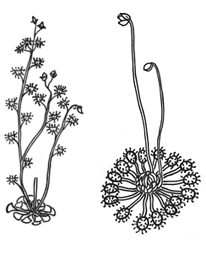
Description: Perennial or annual herbs with rhizomes, fibrous roots, or tubers with vertical underground stolon. Stems usually very short, sometimes long and erect, [or climbing and to 1.5 m long].
Leaves circinate, either all basal in a rosette, or basal and cauline, or all cauline, the upper surface covered with glandular hairs that trap insects, rarely leaves glabrous.
Flowers mostly in cymes, often raceme-like, or solitary, usually terminal, often glandular. Sepals, petals and stamens mostly 5, free or the sepals shortly united at base.
Fruit a loculicidal capsule.
Distribution and occurrence: World: about 90 species, world-wide. Australia: 54 species (42 species in SW Australia), all States.
Drosera aberrans (Lowrie & Carlquist) Lowrie & Conran was collected in 1876 in the south west of NSW on the Edward River in the Riverina area. This species is widespread in Victoria and South Australia. Telopea 12(2) 147–165 (2008).
Text by G. J. Harden
Taxon concept:
| | Key to the species | |
| 1 | Cauline leaves peltate with lamina concave, circular, reniform or crescent-shaped | 2 |
| Cauline leaves absent, if present then lamina linear, spathulate or fan-shaped, not peltate | 6 |
| 2 | Sepals variously hairy, sometimes glabrous; margin fimbriate | 3 |
| Sepals glabrous; margin entire, erose or denticulate
Back to 1 | 4 |
| 3 | Basal rosette of leaves red; cauline leaves <6 mm wide; sepals 0.1–1.5 mm wide; seeds ovoid to obovoid,0.4–0.8 mm long, with surface shallowly reticulate | Drosera peltata |
| Basal rosette of leaves yellow-green; cauline leaves up to 10 mm wide; sepals 0.7–2.4 mm wide; seeds cylindrical, pandurate to obovoid, 0.5–0.8 mm long, with surface deeply pitted
Back to 2 | Drosera hookeri |
| 4 | Seeds always cylindrical, usually > 1 mm long | Drosera auriculata |
| Seeds ovoid or arachiform, rarely cylindrical and then < 1 mm long
Back to 2 | 5 |
| 5 | Seed surface shallowly pitted; seeds ovoid, < 0.4 mm long | Drosera lunata |
| Seed surface deeply pitted; seed shape variable, ovoid, arachiform to shortly cylindrical, 0.5–0.8 mm long
Back to 4 | Drosera hookeri |
| 6 | Leaves simple, linear or if forked then lobes linear | 7 |
| Leaves simple, varying from orbicular, obovate to flabellate, never linear nor forked
Back to 1 | 10 |
| 7 | Leaves cauline, simple | Drosera finlaysoniana |
| Leaves basal, simple or forked
Back to 6 | 8 |
| 8 | Leaves usually forked once, sometimes more; lobes 20–100 mm long; corolla white | Drosera binata |
| Leaves simple, unlobed; corolla white to pink-mauve
Back to 7 | 9 |
| 9 | Inflorescences 15–30-flowered; corolla usually pink-mauve (cultivars of dark pink or white are available) | Drosera capensis |
| Inflorescences 1(–2)-flowered; corolla white
Back to 8 | Drosera arcturi |
| 10 | Leaves sessile or petiole shorter than lamina | 11 |
| Leaves with a distinct petiole, longer than the lamina
Back to 6 | 12 |
| 11 | Bracts simple; calyx minutely glandular; styles 3, divided in 2 to base | Drosera spatulata |
| Bracts trifid; calyx tuberculate; styles 5, filiform
Back to 10 | Drosera burmanni |
| 12 | Sepals and petals 5; inflorescence many-flowered, flowers orange or red; leaves not peltate, 10–20 mm long | Drosera glanduligera |
| Sepals and petals 4; flowers solitary, white; leaves peltate, 3–7 mm long
Back to 10 | Drosera pygmaea |
|


